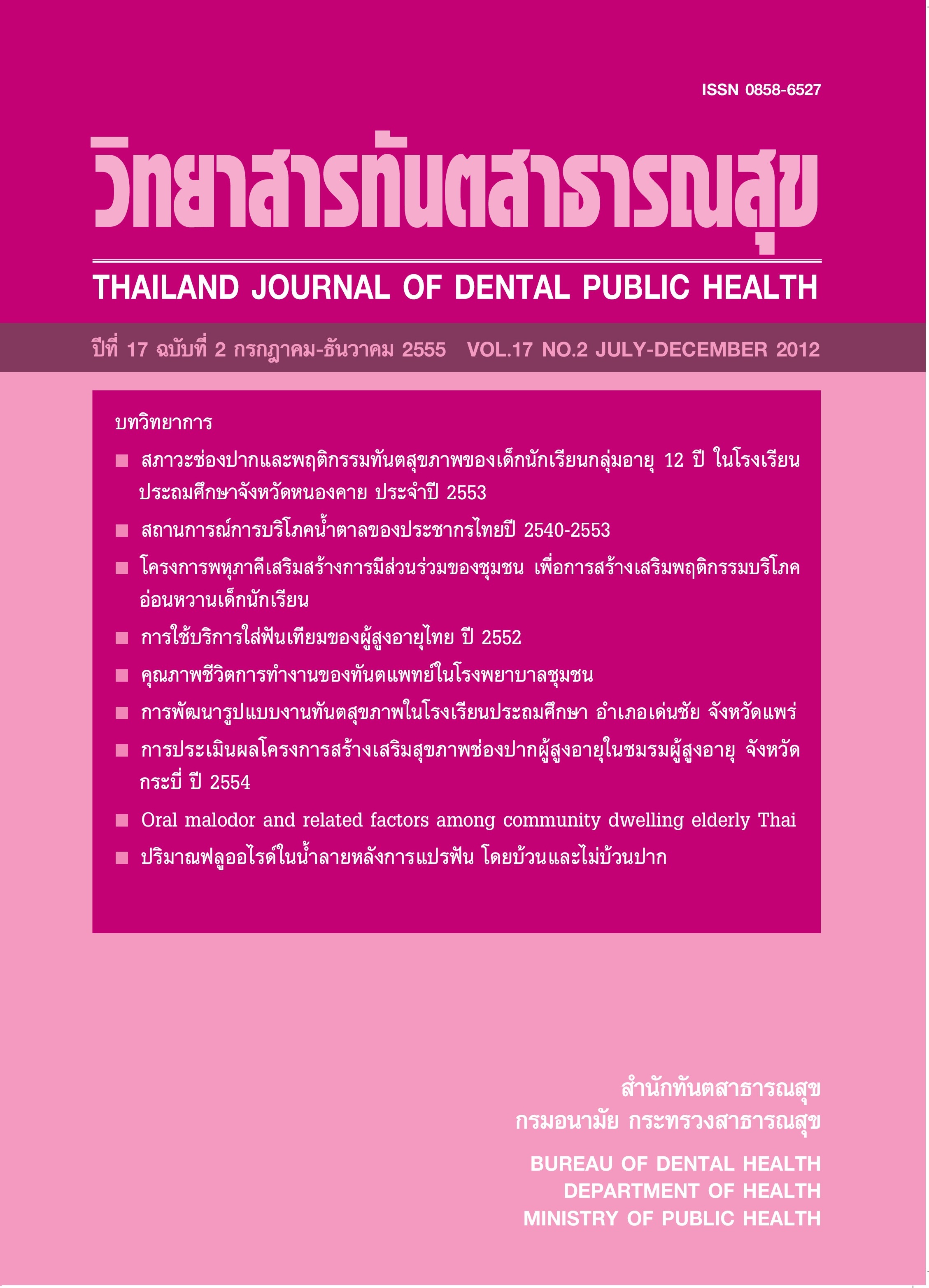Fluoride content in saliva following tooth brushing with and without rinsing.
Main Article Content
Abstract
Fluoride toothpaste is an important mean of daily fluoride uptake but water rinsing after tooth brushing leads to fluoride loss from the oral cavity. The objective is to compare the fluoride content in saliva following tooth brushing with and without water rinsing. The 12 healthy 5 th year dental students were participated. On the first day, not less than 4 hours after brushing with no fluoride content toothpaste, the resting saliva was collected. After brushing with 1 gram of 1,000 ppm fluoride toothpaste for 2 min. and discarded a slurry of the toothpaste foam for 30 seconds, the saliva were collected at 2, 5,10 and 15 min. Fluoride concentration in all samples was measured by fluoride ion electrode. On the other days, the experimented were performed by 3 min rinsing with 10 ml deionized water once and twice after slurry were discarded, respectively. The differences of fluoride content in saliva after brushing with and without rinsing were analyzed by Kruskal-Wallis test at 95% confident limit. The results showed that fluoride content in saliva following tooth brushing without rinsing, 1 and 2 rinsing at 2 min. were 3.850+2.483, 2.285+1.620, 0.847+0.597 ; at 5 min. were 1.384+0.677, 0.735+0.365,0.387+0.211; at 10 min. were 0.789+0.872, 0.338+0.263, 0.139+0.075; and at 15 min. were 0.300+0.303, 0.204+0.251, 0.086+0.058 ppm respectively. All data showed significant differences (p<.05). It was concluded that fluoride contents in saliva following tooth brushing after 1and 2 rinsing were lower than those without rinsing.
Downloads
Article Details
References
2. Ten Cate JM. Current concepts on the theories of the mechanism of action of fluoride. Acta Odontol Scand 1999;57:325– 9.
3. Sjögren K, Melin NH. The influence of rinsing routines on fluoride retention after toothbrushing. Gerodontology 2001 Jul;18(1):15-20.
4. Issa AI, Toumba KJ. Oral fluoride retention in saliva following toothbrushing with child and adult dentifrices with and without water rinsing. Carries Res 2004 Jan-Feb;38(1):15-9.
5. Al-Mulla A, Karlsson L, Kharsa S, Kjellberg H, Birkhed D. Combination of high-fluoride toothpaste and no post-brushing water rinsing on enamel demineralization using an in-situ caries model with orthodontic bands. Acta Odontol Scand. 2010;68:323–8.
6. Chestnutt IG, Schäfer F, Jacobson AP, Stephen KW. The influence of tooth brushing frequency and post-brushing rinsing on caries experience in a caries clinical trial: Community Dent Oral Epidemiol. 1998; 26:406-11.
7. Sjögrena K, Ekstrandb J, Birkheda D. Effect of Water Rinsing after Toothbrushing on Fluoride Ingestion and Absorption. Caries Res 1994; 28(6):455-9.
8. Whitford GM. Acute and chronic fluoride toxicity. J Dent Res 1992; 71(5):1249-54.
9. อารีย์ เจนกิตติวงศ์ ชลธิชา พิพิธพัฒนากร นิศา จิตติวัฒนพงศ์ หทัยชนก เจริญพงศ์ อัตราการหลั่งของน้ำลาย และค่าความเป็นกรดด่างของน้ำลายภายหลังการกระตุ้นด้วยการเคี่ยวหมากฝรั่ง,
ว ทันต จุฬาฯ 2545;25:95-102.
10. Zamataro CB, Tenuta LM, Cury J.A. Low-fluoride dentifrice and the effect of post brushing rinsing on fluoride aviable in saliva: Eur Arch Paediatr Dent. 2008 Jun;9(2):90-3.
11. Dawes C.Factors influencing salivary flow rate and composition . In:Edgar WM, O’Mullane DM. Saliva and health 2 nd ed. London: Thanet Press Limited, 1996:27-43.
12. Palomares CF, Muñoz-Montagud JV, Sanchiz V, Herreros B, Hernández V, Mínguez M, Benages A. Unstimulated salivary flow rate, pH and buffer capacity of saliva in healthy volunteers. Rev Esp Enferm Dig 2004; 96(11) : 773-84.
13. กระทรวงสาธารณสุข. ประกาศกระทรวงสาธารณสุขฉบับที่ 6 พ.ศ.2552 เรื่องน้ำบริโภคในภาชนะทิ่ปิดสนิท. ราชกิจจานุเบกษา ฉบับประกาศและการใช้งานทั่วไป 2553 พฤษภาคม; 127
(67ง)
14. Pollack RL, Kravitz E. Nutrition in Oral Health and Disease. Philadelphta: Lea & Febiger; 1985. p. 456.
15. Fluoride in drinking water. Available from http://www.who.int/water_sanitation_health/dwq/chemicals/fluoride.pdf


